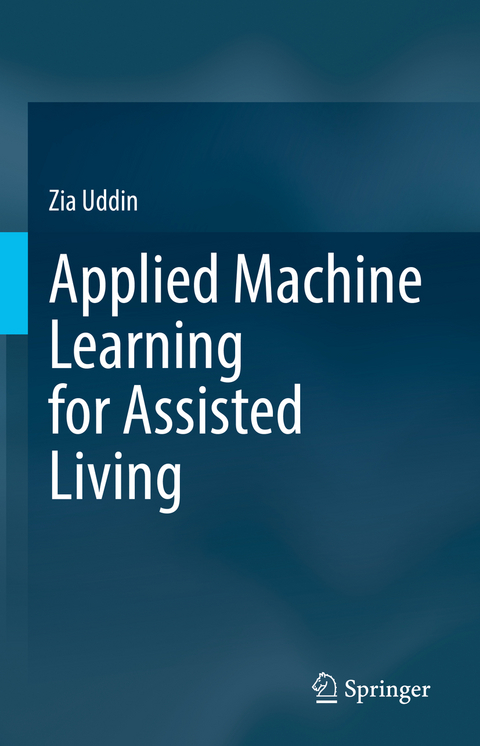
Applied Machine Learning for Assisted Living
Springer International Publishing (Verlag)
978-3-031-11533-2 (ISBN)
Research that is related to the use of user monitoring technologies in assisted living is very widespread, but it is still consists mostly of limited-scale studies.
User care at home is a matter of great concern since unforeseen circumstances might occur that affect people's well-being. Technologies that assist people in independent living are essential for enhancing care in a cost-effective and reliable manner. Assisted care applications often demand real-time observation of the environment and the resident's activities using an event-driven system. As an emerging area of research and development, it is necessary to explore the approaches of the user care system in the literature to identify current practices for future research directions.
Therefore, this book is aimed at a comprehensive review of data sources (e.g., sensors) with machine learning for various smart user care systems. To encourage the readers in the field, insights of practical essence of different machine learning algorithms with sensor data (e.g., publicly available datasets) are also discussed. Some code segments are also included to motivate the researchers ofthe related fields to practically implement the features and machine learning techniques. It is an effort to obtain knowledge of different types of sensor-based user monitoring technologies in-home environments. With the aim of adopting these technologies, research works, and their outcomes are reported. Besides, up to date references are included for the user monitoring technologies with the aim of facilitating independent living.
Research that is related to the use of user monitoring technologies in assisted living is very widespread, but it is still consists mostly of limited-scale studies. Hence, user monitoring technology is a very promising field, especially for long-term care. However, monitoring of the users for smart assisted technologies should be taken to the next level with more detailed studies that evaluate and demonstrate their potential to contribute to prolonging the independent living of people. The target of this book is to contribute towards that direction.
Md Zia Uddin completed his PhD in Biomedical Engineering in 2011. Then, he served as a faculty member in reputed universities with good world ranking such as Sungkyunkwan University (QS world ranking 88 in 2021). He is currently working as a Senior Research Scientist in Sustainable Communication Technologies department of SINTEF Digital, Oslo, Norway. SINTEF is the largest research institute in Scandinavia and one of the largest research institutes in Europe.His research fields are mainly focused on data & feature analysis from various sources (sensors and others) for physical/mental healthcare using machine learning/artificial intelligence. Dr. Zia also has a good teaching experience with more than 20 computer science-related courses from bachelor's degree to PhD. He has got more than 130 peer-reviewed research publications including prestigious international journals, conferences, and book chapters. His google scholar citations are around 3000. He got Gold Medal Award (2008) for academic excellence in undergraduate study. He was also Awarded Korean Government IT Scholarship (March 2007 to February 2011) and Kyung Hee University President Scholarship (March 2007 to February 2011). His research works received best/outstanding paper awards in several peer reviewed international conferences. He acted as a reviewer in enormous conferences and many prestigious journals including IEEE Transactions on Pattern Analysis and Machine Intelligence (TPAMI), Information Fusion, IEEE Transactions on Industrial Informatics, and IEEE Transactions on Biomedical Engineering, etc. Dr. Zia has been recently enlisted in the World's Top 2% Scientists for Single Year 2019 and 2020 by Stanford University of USA and Elsevier BV done in 2020 and 2021, respectively.
1.Assisted Living.- 1. 1. Introduction .- 1.2. Surveys on Assisted Living.- 1.3. Assisted Living Projects.- 1.4. Target Users.- 1.4.1. Indoor Observations.- 1.4.2. Outdoor Observations.- 1.5. Privacy and Data Protection.- 1.6. Conclusion.- References.- 2. Sensors and Features for Assisted Living Technologies .- 2.1. Sensors in User care.- 2.1.1. Wearable Sensors.- 2.1.2. Smart Daily Objects.- 2.1.3. Environmental Sensors.- 2.1.2. Wearables with Ambient Sensors.- 2.1.3. Ambient Sensors in Robotic Assisted Living.- 2.2. Feature Extraction.- 2.2.1. Feature Extraction Using PCA.- 2.2.2. Kernel Principal Component Analysis (KPCA).- 2.2.3. Feature Extraction Using ICA.- 2.2.4. Linear Discriminant Analysis (LDA).- 2.2.5. Generalized Discriminant Analysis (GDA).- 2.3. Discussion.- 2.4. Conclusion.- References.- 3. Machine Learning.- 3.1 Shallow Machine Learning.- 3.1.1. Support Vector Machines.- vii.- 3.1.2. Random Forests.- 3.1.3. AdaBoost and Gradient Boosting.- 3.1.4. Nearest Neighbors .- 3.1.5. Examples.- 3.2. Deep Machine Learning.- 3.2.1. Deep Belief Networks (DBN).- 3.2.2. Convolutional Neural Network.- 3.2.3. Recurrent Neural Networks.- 3.2.4. Neural Structured Learning.- 3.2.4. Pre-trained deep learning models.- 3.3. Explainable AI (XAI).- 3.3.1. Local Explanations.- 3.3.2. Rule-based Explanations.- 3.3.3. Visual Explanations.- 3.3.4. Feature Relevance Explanations.- 3.4. Discussion.- 3.5. Conclusion.- References .- 4. Applications.- 4.1. Wearable Sensor-based Behavior Recognition.- 4.1.1. MHEALTH Dataset.- 4.1.2. Experimental Results on MHEALTH Dataset.- 4.1.3. PUC-Rio Dataset.- 4.1.4. Experimental Results on PUC-Rio Dataset.- 4.1.5. ARem Dataset.- 4.1.6. Experimental Results on AReM Dataset.- 4.3. Video Camera-based Behavior Recognition.- 4.3.1. Binary Silhouettes and Features.- 4.3.2. Depth Silhouettes and Features.- 4.3.3. 3-D Model-based HAR.- 4.4. Other Ambient Sensor-based Behavior Recognition.- 4.4.1. CASAS Dataset.- viii.- 4.4.2. Experimental Results.- 4.5. Conclusion.- References.
| Erscheinungsdatum | 01.09.2022 |
|---|---|
| Zusatzinfo | XI, 131 p. 60 illus., 52 illus. in color. |
| Verlagsort | Cham |
| Sprache | englisch |
| Maße | 155 x 235 mm |
| Gewicht | 382 g |
| Themenwelt | Informatik ► Software Entwicklung ► User Interfaces (HCI) |
| Informatik ► Theorie / Studium ► Künstliche Intelligenz / Robotik | |
| Medizin / Pharmazie | |
| Technik | |
| Schlagworte | assisted living applications • Data • human centered computing • machine learning • text based event • User Interfaces |
| ISBN-10 | 3-031-11533-3 / 3031115333 |
| ISBN-13 | 978-3-031-11533-2 / 9783031115332 |
| Zustand | Neuware |
| Haben Sie eine Frage zum Produkt? |
aus dem Bereich


